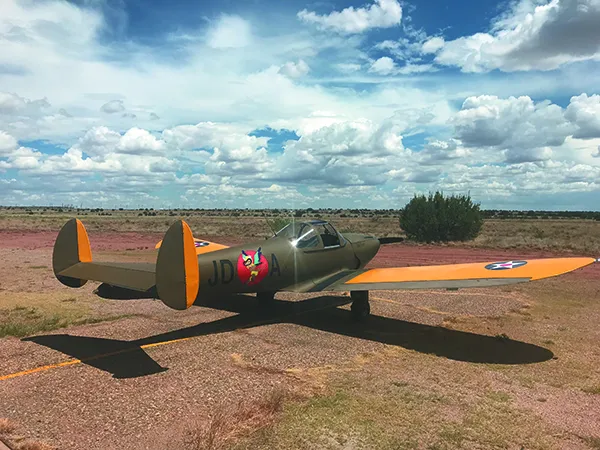Shopping the market for a fun, reasonably affordable and easy-to-fly two-placer? Add the Ercoupe to the list of potential candidates. Nearly 82 years later, owners still appreciate the Ercoupe’s intended design as an exceptionally safe airplane that’s resistant to stalls and spins.
But there’s more bragging rights. It’s really the first successful production GA airplane that had a nosewheel, plus a fully cowled engine. This contributed to more speed than most of its counterparts had. Better yet, an Ercoupe can handle a big crosswind—and we’re talking a breeze with twice the velocity that can be dealt with by almost any other airplane.
These days, by nature of its design, the Ercoupe doesn’t come across as having an abundance of testosterone, so what may be the funkiest two-place airplane from the 1940s is a bit of a sleeper on the used market. We think it’s overlooked by potential buyers who don’t understand its capabilities. Owners seem to love their Ercoupes for a variety of reasons, including ramp appeal. It’s a head turner, especially when decked out in interesting paint schemes.
Even in the current market where aircraft values are through the roof, the venerable ‘coupe remains one of the cheapest ways to get in the air, although pristine models fetch top dollar. The current Aircraft Bluebook value on a nicely maintained Ercoupe retails for around $20,000, and some can be had for lower, but remember these are old birds. As with any vintage airframe, it’s easy to get stuck with a problem child.
Many don’t realize that 20-year-newer (1968 to 1970) Mooney Cadets—which are Ercoupes with a single tail and rudder pedals—are also somewhat affordable.
The C model, the only one that has a low enough gross weight to qualify under light sport, has become an in-demand airplane. And there’s a lot to like, which most owners will attest. It’s simply a fun airplane suitable for Saturday afternoon joyrides on nice days or even modest cross-country trips. You can fly along with the canopy open, your elbow out in the breeze, and pass the folks in their two-place Pipers and Aeroncas. Those cost more and have the engine cylinders dragging along in the breeze. But not the more refined Ercoupe.
Owners tell us the Ercoupe is what it is: a fun, easy-to-fly airplane with few bad habits that’s a good choice for a starter airplane.
On the other hand, a prospective buyer shouldn’t go into the deal looking for a steal. Like any old airplane, there is no free lunch.
Of all the Ercoupe models to choose from, we think the later Alon and Forney models may be the better values, even if they cost a little more.
The early airplanes had fabric wings—a plus for inspections—but the later models with metal wings have been equipped with inspection panels, so hidden corrosion is less of a worry. It can be found, if you look.
Last, don’t expect too much of an Ercoupe. If you have places to be and things to do and serious cross-country is on your list of desires, the Ercoupe is not a good choice. But it’s an eminently affordable and maintainable weekend fun flyer with a certain 1940s classic panache. Sound intriguing? Read on.
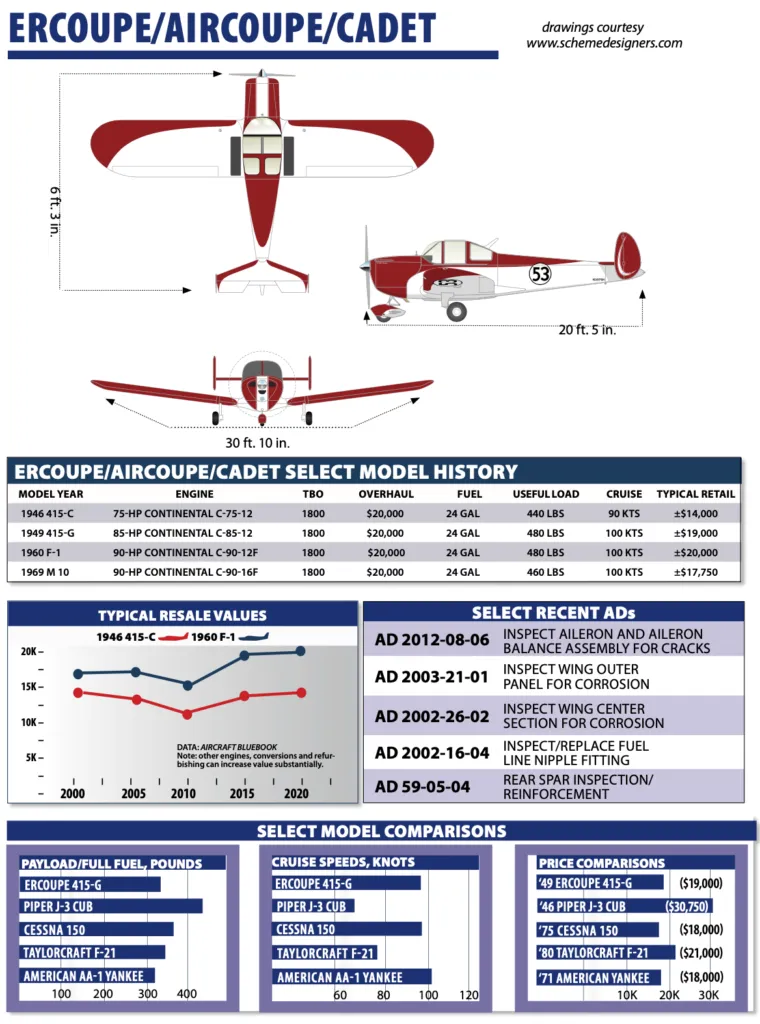
HISTORY
The airplane has a long, complex history with on-again, off-again production dating back prior to World War II and then the brief, but intense, postwar boom.
The first model appeared in 1939, and was manufactured by the Engineering Research Corp. (ERCO), which was the source of the “ER” in Ercoupe. It was designed by Fred Weick, very much an aeronautical genius, who went on to design the first truly crashworthy ag-plane, which became the Piper Pawnee, and to collaborate on the design of the Piper Cherokee line. As a National Advisory Committee for Aeronautics (predecessor of NASA) engineer, Weick had designed the Weick W-1 in response to a call for an airplane that could not be stalled.
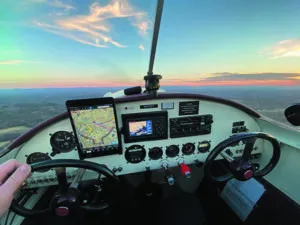
Back then, the W-1’s design was a very big deal because stalls were even worse killers than they are today. They weren’t we’ll understood, and the small engines available for GA meant shaky performance and a relatively small envelope between cruise and stall speeds.
Weick went to work for ERCO and used many of the techniques he’d developed with the high-wing W-1, including limiting up-elevator travel for stall resistance, for the low-wing Ercoupe.
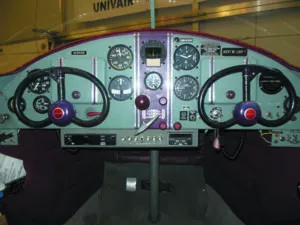
Production continued on the original Ercoupe through 1941, when the attack on Pearl Harbor brought all U.S. civil aircraft manufacturing to a standstill. Some 112 were built before the war.
Postwar, ERCO got in high gear and pumped out more than 4000 75-HP ‘coupes in 1946, an impressive volume second only to Mr. Piper’s Cub. These models are known as the 415-C and they have a four-cylinder Continental C-75-12. (Many have been converted to C-85-12 engines.)
The Model C and CD, with a 1260-pound gross weight, are the only Ercoupes that qualify for light sport.
Production of the 415-C, D, E and G models continued until 1950. Model changes in the C and D were minimal, but the D model got a weight increase to 1400 pounds by further limiting up-elevator travel. The C and D had 75-HP engines while the E and G had 85-HP powerplants. The E and G models also had split elevators.
The postwar boom evaporated by 1947, hitting the two-place market hard. ERCO soldiered on until 1950, eventually building about 5000 airplanes. It then sold the Ercoupe type certificates to Univair. Univair didn’t build any complete airplanes, but did support the line with new parts.
In 1958, a company called Forney took over production rights and introduced a spruced-up model called the Fornair F-1 Aircoupe. The F-1 ‘coupe had a 90-HP Continental C-90-12F, but otherwise retained most of the design features that ERCO had developed. Forney built a couple hundred airframes before retiring production.
Rights to the airplane were eventually purchased by Alon Inc., which built 245 airplanes between 1962 and 1967. Alons have a bubble canopy rather than the sliding windows found in the earlier models.
Surprisingly, the line was then sold to Mooney—yes, Mooney—which made major modifications to the airframe, including a single tail in place of the original’s Lockheed-like twin-fin design, and retained the rudder pedals, which Alon had added when it took over the design. (You can add pedals to any Ercoupe via a kit sold through Univair—www.univair.com—for about $1400.)
Mooney had in mind a basic trainer and called the revised model the Cadet. But it wasn’t much of a seller. Only 118 airplanes were made between 1967 and 1970.
By 1973, rights were sold back to Univair, the same company that had bought the design from ERCO. As before—and still—Univair supported the airplane with new parts production. All told, nearly 5800 ‘coupes were built, with the last one coming out of the Mooney plant in 1970. For all practical purposes, however, the majority of Ercoupes were built between 1945 and 1952.
EYE-CATCHING DESIGN
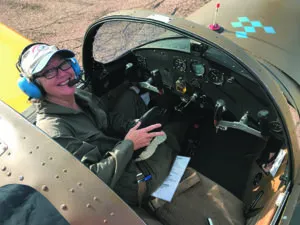
Back in the day, most civil aircraft were covered in fabric stretched over welded tubular frames, but the ‘coupe was an all-metal, riveted design but with fabric-covered wings on early models, later changed to all metal.
The Ercoupe had a pair of vertical fins on a single tail boom, a design that had become popular with Lockheed and Beech twins in the 1930s. And although the Ercoupe had rudders, it had no rudder pedals. The cockpit floor has but one pedal, for the brakes, helping with legroom for tall pilots. The twin tails put the rudders outside the twisting propwash, designing out some, but not all, of the left-turning tendency in a climb. The airplane still needs right wheel during a climb.
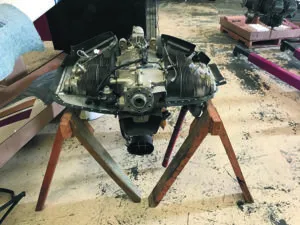
Weick set out to confront two safety issues of the day: stall/spins and groundloops. That meant the Ercoupe was one of the first civil aircraft to take advantage of what was being learned about the stability of a nosewheel versus a tailwheel for control on takeoff and landing. It took the rest of the industry another decade to adopt this visionary idea.
Further, the Ercoupe had a collar on the control column that limited elevator up travel—if you can’t reach the critical angle of attack, you can’t stall the airplane. And if you can’t cross control—remember, no rudder pedals—you can’t spin it, either. The airplane has rudder control, but it is automatically coordinated with the ailerons through a mechanical linkage (only the rudder on the inside of a turn deflects).
The no-stall, no-spin philosophy
drove the design entirely. The restricted elevator travel required a nearly constant CG so the Ercoupe had side-by-side seating. The lack of rudder controls presented a theoretical problem on crosswind landings, so Weick’s solution was a rugged trailing-beam gear design that allowed the airplane to be plunked down in crosswinds, without the usual sideslip correction.
Owners say the gear is more than beefy enough to stand the load of landing in a crab, and control authority is sufficient to keep the airplane tracking correctly once it’s on the pavement. You can do a bad landing in an Ercoupe, but it takes effort to damage the gear.
It’s not, as some think, a castering crosswind gear as in some versions of the Cessna 190/195. After a crabbed touchdown, the airplane immediately turns to point in the direction it is traveling, so you feel the sideload on touchdown. You then steer the airplane with the control wheel during rollout, turning slightly away from the wind to counteract the tendency of the airplane to weathervane.
Rudder purists sneered, but the Ercoupe was successfully tested in crosswinds up to 40 MPH—far beyond the capability of almost any aircraft, then or now. True, it took nerve to drive the thing on in a stiff crosswind, but the gear proved up to the task. With the landing gear properly adjusted and the top of the tails 75 inches above the ground, the wing sits at a zero-degree angle of attack when the airplane is on the ground. This allows landings to be performed at speeds up to an incredible 110 MPH, although owners we spoke with were not willing to try such a speed.
NO-SLIP LANDINGS
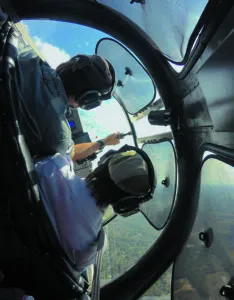
When Boeing came along with its Dash 80, the 707/717/KC-135 prototype, it used the little Ercoupe to train pilots to land the new airplane. Because of its low-slung engine pods, the new jetliner couldn’t be slipped to a landing. Pilots had to learn to land it in a crab and ride out the rudder-induced correction.
And, in fact, the initial design was good enough not to require much meaningful fiddling. Rudder pedals were made available as an option in 1949, mostly as a psychological crutch to entice pilots who thought a “real” airplane had to have pedals.
In most Ercoupe models, fuel capacity is 24 gallons, in two 9-gallon wing tanks and a 6-gallon header tank between the panel and the engine. An engine-driven pump sends fuel from the wing tanks to the header tank, from where it gravity feeds to the carburetor.
There is a float with a wire sticking out of the header tank. Once it starts down, either because all of the fuel in the wing tanks is depleted or the engine-driven fuel pump has failed, you have about an hour before it gets quiet up front. As with some Cessnas, there’s no fuel tank selection, just a simple on/off switch located on the cockpit sidewall.
From a crashworthiness standpoint, the fuel system design is grim. The wing fuel tanks are in front of the spar, unprotected on impact. The header tank, as with too many of the Ercoupe’s contemporaries, is between the occupants and the engine.
The airplane developed somewhat of a “not a real” image for its lack of rudder pedals. The ‘coupe was too easy to fly, suggesting that anyone who would own one didn’t have the right stuff at a time when the phrase hadn’t even been coined yet. This is an absurd state of affairs, of course, and one that seems to dog every radical safety idea, from seat belts up to and including ballistic parachutes.
After a series of minor engineering changes, the Forney airplanes got all-metal wings. To this day, there are debates as to whether this was an improvement. Alon added a sliding canopy, replacing the earlier slide-up/down windows.
Reverting to high-testosterone thinking, Mooney, calling it the M-10 Cadet, revamped the Ercoupe’s image by installing a single tail—complete with the trademark “backward” vertical leading edge and angled trailing edge. The Cadet also had standard rudder pedals, with enough elevator authority to actually stall briskly and even stall strips, so the airplane would stall like a “real” airplane.
NO SPEEDSTER
But it’s not terribly slow, either, compared to, say, a Cessna 150. But it looks faster. With its twin tails and somewhat streamlined fuselage, it does all right. Despite having a fat, low aspect ratio wing that’s excellent for slow-speed and stall characteristics, but middling for climb and cruise, a 90-HP Ercoupe will easily run with a Cessna 150 or Luscombe.
But don’t plan on breaking any altitude records. A 75-HP Ercoupe will struggle climbing above 5000 feet on a warm day with two people aboard; solo, it does better. One owner said his 85-HP model with a climb prop “loves the ground.” He noted that if you put two people and some baggage aboard, you know you’re really carrying a major load. “They claim 500 FPM for the first five minutes, but mine never does that well.” Others we talked to agree.
Be careful with it at tight strips—it uses much more runway departing than it does landing. The twin tail design did not eliminate all of the left-turning tendency—P-factor is still there—so allowing the speed to get much below 75 MPH in a climb means there will be so much drag from aileron and rudder deflection that the climb rate can be frighteningly low when trying to clear an obstacle when it’s hot and heavy.
Like other airplanes of the day, such as the J-3 Cub and Champion, the Ercoupe is not an all-purpose machine, performance wise. The 75-HP models will be zippy enough for solo flying but if you want to do much two-person flying, try to find a 90-HP Alon model or, at the least, an 85-HP version with a climb prop where there’s a noticeable difference in performance.
In flat-out cruise, among the postwar designs, Ercoupes hold their own, and then some. Plan on around 100 MPH in 75- and 85-HP models and perhaps as much as 110 MPH in the 90-HP models.
By comparison, you’d be lucky to see 80 MPH in an early Cub, and even late-model Cessna 150s struggle to make 110 MPH.
But an Ercoupe really will handle strong crosswinds. Owners reported landing in direct crosswinds of more than 30 MPH. In previous reports, folks at the Ercoupe Owners Club confirmed the ability of the airplanes to land in very strong crosswinds, but noted that one place where Ercoupe pilots do get into trouble is attempting to take off in very strong crosswinds. See the accident scan sidebar on this page for more troubles.
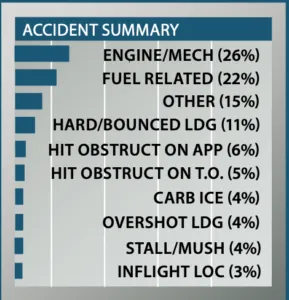
Our review of the 100 most recent Ercoupe/Aircoupe accidents was notable for what we didn’t find. There were no VFR into IMC crashes—we wonder if there is something about the aircraft that protects its pilots from one of the most common methods of slipping one’s mortal coil in an airplane.
In addition, there were no runway loss of control (RLOC) accidents on runways that weren’t constructed of ice. None. We expect to see at least 20 RLOC events when we review an aircraft type—the absolute absence of them for the Ercoupe says it all when it comes to its ground-handling qualities. We note that when an Ercoupe’s gear is rigged correctly, it has a nearly zero angle of attack when on the ground, so it may be landed at any speed, up to and including cruise.
Oh, yes, there was one RLOC crosswind takeoff accident on a runway plowed free of snow on a frozen lake. The Ercoupe slid into the snow piled on one side of the runway—not a design fault.
While it is almost impossible to stall a properly-rigged Ercoupe (limited up-elevator travel usually prevents reaching stalling angle of attack) there is never any free lunch in aircraft design so there is a tradeoff for stall protection. With full up elevator, the airplane reaches its minimum speed airborne of 60 MPH. That’s also where the overall drag of the airplane is high—so high that at high density altitudes and/or heavily loaded, the airplane may simply be unable to climb at full power. The airplane has to be accelerated to Vx or Vy to have any hope of ascending. In a steep turn the airplane may be unable to hold altitude unless the angle of bank is reduced.
On approach, slowing to 60 MPH with the power off means an Ercoupe will develop a descent rate akin to that of a dropped sewer cover. Breaking the descent may require full power and accelerating. Accelerating may require sacrificing more altitude than is available. That feature/quirk of the airplane is part of the reason we saw 11 hard/bounced landings that led to bent airplanes and six events in which the pilot hit something—including the ground— short of the runway.
The most frequent cause of Ercoupes coming to grief in flight proved to be poorly performed maintenance or lack of maintenance. We saw numerous examples of neglect of basic maintenance in the 26 engine power loss accidents. Of the 22 fuel-related accidents (a very high number, in our opinion), six involved contamination, some of which was material that had clearly been in the fuel system for some time before it became bad enough to stop the flow of fuel.
The Ercoupe’s fuel system is not intuitive. Fuel in the wing tanks is pumped into a header tank forward of the cockpit. From there, it gravity feeds to the engine. The quantity in the header tank is indicated by a sight gauge mounted on a cork float. The header tank remains full until the wing tanks are empty. If the pump transferring fuel from the wing tanks fails, the fuel in the wing tanks becomes unavailable. Pilots who didn’t understand that and watched the header tank fuel quantity approach zero while seeing lots of fuel in the wing tanks later expressed surprise when the engine quit due to fuel exhaustion.
HANDLING
Yes, an Ercoupe is different, but that’s part of the attraction. With no rudder pedals, a canopy, windows you can open in flight and systems straight out of the 1940s, flying an Ercoupe is an interesting experience. It’s far from your average two-placer.
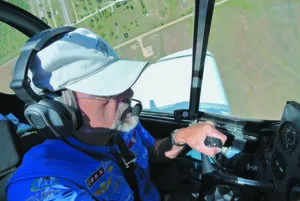
In general, the Ercoupe is a good flyer with appealing handling characteristics. It has full-span ailerons (remember, no flaps), so roll response is far snappier than other airplanes of the same era. Properly rigged, it will not stall—the up-elevator restriction means the airplane has a “minimum speed” in 1 G flight. It won’t go any slower and with power off, it simply descends under full control.
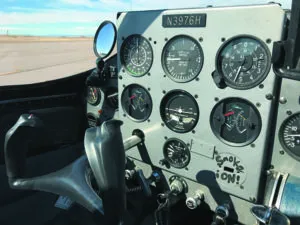
The downside is that the sink rate can become eye-watering. Some landing wrecks are due to the pilot failing to arrest a high sink rate after getting slow. Folks who know how to really fly these airplanes told us that besides trying to take off in a stiff crosswind, the second most common area where Ercoupe pilots get into trouble is allowing a high sink rate to develop.
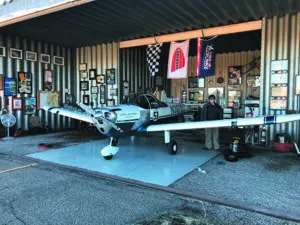
Also, in a steep turn, you may reach full aft wheel and full power but be unable to maintain altitude—potentially developing a stunning rate of descent. The only way to stop the sink is to roll out of the turn. It may be necessary to fly level to accelerate to a speed at which the airplane will begin to climb. But, the rapid rate of descent allows for precise and impressive short-field landings. If you’re not careful, the same trait can and will put you in the weeds short of the approach end of the runway.
Once the airplane has been slowed to its minimum speed on final, it will not flare without adding a lot of power because the yoke is already fully aft. In reality, an Ercoupe is quite easy to land. The trailing beam gear is forgiving, usually soaking up the too-high arrival rate of a ham-fisted pilot. In a bouncy crosswind, just crab the airplane into the wind and touch down as you would with no crosswind.
The airplane will reliably right itself on the runway and the rest is easy, although you do have to steer away from the crosswind—counterintuitive for aileron positioning for pilots who fly three-control airplanes.
What about adding rudder pedals? We heard from one Ercoupe pilot who thinks the rudder pedal mod is actually dangerous because it’s not connected to the nosewheel and may confuse pilots about ground handling. On the ground, you drive the Ercoupe like a car, steering with the control yoke, not the pedals.
SUPPORT
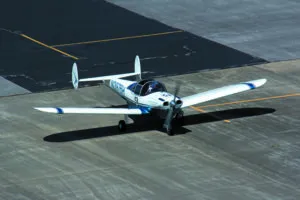
Hands down the best thing you can do is join the Ercoupe Owners Club (www.ercoupe.org), which is passionate about the care and feeding of the marque and has a good website and newsletter for all things Ercoupe. There are also several good Facebook groups, including the 2000-plus-member Ercoupe Owners & Enthusiasts.
The best source of parts continues to be Univair (www.univair.com), which holds the type certificate for the airplane and makes most structural parts.
Another company, Skyport Services (www.skyportservices.net), specializes in Ercoupe parts, STCs and accessories and is a cornucopia of ‘coupe-iana, including an STC for gross weight increase.
The largest area of concern with an Ercoupe is corrosion. There have been two ADs calling for inspection for corrosion in the wings, AD 2002-26-02 and AD 2003-21-01. Buy the wrong airframe and you could face potentially uneconomic repair costs. Since many Ercoupes have and continue to live outdoors, water incursion is a worry.
Water tends to leak into the fuselage and corrode the belly skins. The tail cone and wing spar lower caps are also corrosion-prone areas. Mice can also be destructive. Look out for nosewheel issues, too—especially the single-fork models on the earlier airplanes. Decades of landings and abuse and side loading due to crabbed landings in crosswinds will take a toll. Shimmy can be a problem due to loose or worn nosewheel linkages. Main gear struts can also be a problem, again due to years of pounding. The shock struts can seize up if they’re too low on fluid, and landing forces are transmitted directly to the wing spar center section. Check it for damage and look for a reinforcement gusset that has been retrofitted to many airplanes.
OWNER COMMENTS
We’ve been the caretakers of Ercoupe N3967H (serial number 4677) since the summer of 2013. In that time, I think the greatest challenge has been in “training” mechanics. We’ve been through a number of different AIs for annuals, which has proven expensive and painful. The plane isn’t really all that complex, but it does have some idiosyncrasies. My advice is to really learn about the airplane yourself, and find a mechanic who is willing to do truly collaborative owner-assisted annuals.
Prior to the light sport rule, the planes didn’t have much value, so many were owned by people who had no right owning an airplane, resulting in a horrifying range of illegal mods and car parts, so getting a bargain-basement plane isn’t always a bargain. That said, the planes really are a bargain: Expect to pay around $25,000 for most of the decent airframes for sale. There are quite a number of ADs—more than on most GA aircraft it seems, but my plane would qualify for Medicare if she was a person—and most of the directives are pretty simple.
One huge advantage that the Ercoupe has over most classic planes is that the type certificate is still supported by Univair. Most of the parts you could ever need are in stock, and the ones that aren’t can generally be made. I’ve heard some owners whine about the prices, but compared to other OEM aircraft parts, I find them quite reasonable. We also have a large “Ercoupe Junkyard” company that has massive inventory of used parts. There’s no need to own two Ercoupes just to keep one flying!
The plane has a low useful load, some might say a useless load. They only have two seats—side by side—and have limited space for baggage. They are slow by current standards, but sip avgas and can also run on mogas.
Is there any good news? Yes! The plane flies like a dream, and thanks to trailing link landing gear, every landing is a greaser. They also have a crazy-high crosswind component, once you get used to the fact you have to land crabbed, and that it won’t hurt the plane. And the doors are just “plane” fun.
There are two models: The newer ‘Coupes have a fighter-plane style sliding canopy. The older ones have a two-part door that can be slid into the belly for flying open cockpit (or open skylight, or open side windows, depending on how you position the doors).
The cockpit is inviting. You step down into it. It feels like you are wearing the plane. The wing loading is light, so they can be a handful in choppy conditions, but the high dihedral makes them very stable the rest of the time. The twin tails are charming, and you can’t land anywhere without turning heads and starting conversations.
We have an active and welcoming type club, and in most years there are a range of fly-in events to attend. The club also has several maintenance advisors you can call for advice and tips, and there’s also a surprising number of STCs available.
Although I hear a lot of people grumbling about increasing insurance, my insurance (AIG through AOPA) has been stable at around a thousand bucks per year for the last several years. That’s for really good coverage.
Currently, two of the models (C and CD) can be flown light sport using the “driver’s license medical.”
William E. Dubois – Sport Air Racing League’s “Race 53”
When I decided to get my sport pilot license, there were no suitable aircraft available for flight training in my area; ownership was my only avenue. A pilot friend suggested an Ercoupe, and took me for a short flight with the windows open. I like convertibles; a convertible with wings? I was hooked. I found N93498 and became an owner.
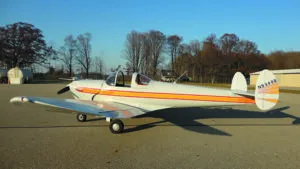
I have owned my Ercoupe 415-C for 10 years. This is the only aircraft I have ever owned, and all of my logged flight time is in this aircraft. I fly only for pure pleasure.
Insurance ($25,000 hull value) runs about $600 per year. Annuals average around $800, unless I elect to add extras while the plane is in the shop.
Since purchasing the aircraft, I have installed the 1320-pound gross weight STC and the shoulder harness STC. Given the short distance from the occupants to the instrument panel, I consider shoulder harnesses to be a safety imperative.
Attention also needs to be paid to the tail height when the aircraft is on the ground. If the tail height is too low, then takeoff, landing and crosswind handling can be adversely affected.
The crosswind capability of this aircraft is excellent. The book says 25 MPH, and while I haven’t gotten anywhere near this limit, I go flying in wind conditions that tend to keep the taildraggers safely in their hangars. I consider crosswind takeoffs to be more challenging than crosswind landings.
The fuel system is beautiful simplicity. There is a 9-gallon tank in each wing, plumbed together so the fuel is drawn simultaneously from both tanks. In flight, fuel is continuously pumped from these tanks by an engine-driven mechanical fuel pump to the 6-gallon fuselage tank, keeping the fuselage tank full.
The fuselage tank has an overflow line back to the wing tanks. Fuel is gravity fed from the fuselage tank to the engine. Continental says the fuel burn is 5.7 GPH at 2400 RPM and for flight-planning, I round that to 6 GPH, giving four hours of endurance.
The cabin is snug. It’s adequate for my 5-foot-6-inch frame, but pilots over 6 feet would find it cramped, I think.
This is a simple aircraft. It is reasonably priced, inexpensive to operate and maintain, and easy to fly. In 10 years of flying, I have been unable to find any hidden vices, and I have never experienced any buyer’s remorse. I like my ‘Coupe!
Wes VanNieuwenhuyzen – -via email
Our thanks to William Dubois for helping with the photos for this report.

